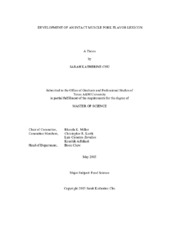| dc.description.abstract | A fresh intact muscle pork flavor lexicon was developed by obtaining cuts of pork (pork loins, shoulders, picnics, tenderloins, fresh ham legs, bellies, enhanced picnics and pork chops) from retail grocery stores. Varying cooking temperatures, cooking techniques, and cuts induced differences in flavors and aromas. These cuts were cooked to various internal temperature endpoints (57.2°C, 62.7°C for roasts, 68.3°C, and 79.4°C) utilizing a high temperature cooking method for chops, and roasting and/or braising for whole muscle cuts.
Five highly trained panelists identified and defined twenty-four aroma and flavor attributes. Pork identity, brown/roasted, bloody/serumy, metallic, and fat-like flavor aromatics, and astringent feeling factors, and 4 of the 5 basic tastes were most prevalent in samples. Validation of the pork lexicon was performed. Trained panelists evaluated tenderloin medallions, and loin chops, inside ham chops, and shoulder chops cooked to four internal endpoint temperatures (62.7°C, 68.3°C, 73.8°C, and 79.4°C). Pork identity, brown/roasted, fat-like, bloody/serumy, metallic, liver-like, and nutty flavor aromatics, and astringent feeling factors, and sweet, sour, salty, bitter, and umami basic tastes were present in samples. All attributes but bitter basic taste (P > 0.05) differed across cuts (P < 0.05). All samples had moderate levels of pork identity flavor aromatics. Umami basic taste and liver-like, nutty, and fat-like flavor aromatics and astringent feeling factors were barely detectable. Shoulder chops were higher in pork identity and fat-like flavor aromatics and umami basic taste. Inside ham chops were higher in astringent feeling factors and metallic flavor aromatics, and sour and bitter basic tastes. Brown/roasted, bloody/serumy, and metallic flavor aromatics, and astringent feeling factors, and sour and bitter basic tastes differed across internal endpoint temperatures (P < 0.05). As internal endpoint temperatures increased, brown/roasted flavor aromatics increased, while bloody/serumy flavor aromatics and astringent feeling factors, and sour and bitter basic tastes decreased.
Gas chromatography with olfactory sniff ports detected volatile aromatic compounds (n=157) found in the samples. Stepwise linear regression equations and simple correlation coefficients were calculated. Stepwise equations used 50, 42, 43, 58, 33, 37, 75, 53, and 42 compounds to account for 93, 91, 83, 94, 77, 87, 96, 88, and 83% of pork identity, brown/roasted, fat-like, bloody/serumy, and metallic flavor aromatics, and astringent feeling factors, and sour, salty, and bitter basic tastes, respectively which determined volatile aroma compounds that may explain variance of trained descriptive attributes. Sulfur-containing compounds, nitrogen-containing compounds, aldehydes, ketones, acids, alkanes, alkenes, furans, pyrazines, and benzenes influenced pork flavor. Aldehydes were quantitatively higher than other compound classes. Aromatic compounds that clustered with treatments and flavor aromatic attributes varied in partial least squares regression biplots, with a large number of treatments and attributes that clustered with aldehydes and alcohols, and treatments that were cooked to higher internal endpoint temperatures clustered with compounds such as pyrazines and thiazoles. | en |


